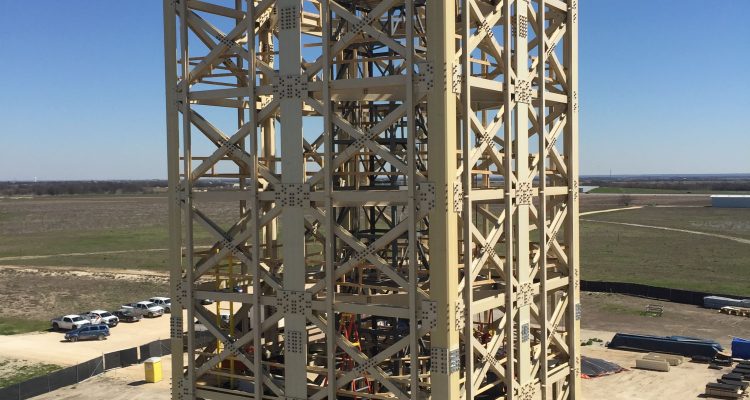A theory about the wireless transmission of energy, developed by inventor Nikola Tesla more than a century ago, helped pave the way for the recent construction of the world’s largest freestanding GFRP tower in Texas.
Viziv Technologies has been researching and building on Tesla’s work for years. The company hopes to use radio waves instead of wires to transmit electric power from a generating source to locations a thousand miles away. One of its experiments involved the use of low-frequency radio waves, which require tall antenna towers for long-distance wave transmission.
To test the feasibility of this approach, Viziv selected composites manufacturer Strongwell to fabricate a nearly 200-foot-tall pultruded GFRP antenna tower.
“We used a composite structure because it is radio transparent at the operational frequencies that we were testing,” says Jim Salvitti, vice president of Viziv’s technology department. Steel structures absorb or reflect radio frequency waves, reducing transmission efficiency. Composite materials, by contrast, allow them to pass through. Wood is also radio transparent, but wooden towers weren’t a viable choice because they couldn’t stand up to the expected winds at that height. Composite materials also offered two other important properties; they can withstand ultraviolet degradation and are resistant to corrosion.
While building the tower with composites was the logical choice, the size of the undertaking presented challenges.
“This project was really pushing the limits of what can be done with pultrusion,” says Barry Myers, corporate director, marketing and communications at Strongwell. The work required a very large pultrusion machine – Myers says the company has the world’s two biggest – plus in-house engineering, design and fabrication expertise. The tower also had to meet Viziv’s demanding performance criteria, including the ability to withstand 115 mph winds.
Strongwell worked with Viziv’s engineering team to develop the right glass fiber and vinyl ester combinations for this application.
“One of the beautiful things about FRP composites is that you can change the lay-up, you can change the reinforcements, you can change the resin,” says Myers. “You’ve got all these different things you can change within a particular shape to get dramatically different performance characteristics.”
The tower is a complex, 20-story lattice-style structure, topped by an aluminum ball that is part of the antenna system. Almost all its components, including the nuts and bolts that hold the sections together, are made from composite materials. The only exceptions are the short stainless steel braces on the bottom tower supports and the clevis plates that bolt the structure to a concrete pad.
The tower is made with wide flange beams, intermediate columns and corner columns for interior support. Strongwell’s Durashield® cladding covers the lower half to protect the electrical equipment located inside. The half-inch thick plates where the pieces of the structure are joined have a lengthwise pin bearing weight of 30,000 psi, which is the maximum load that the plate can withstand before it breaks under bearing stress.
Strongwell employed three different manufacturing processes during the tower’s construction. Since it wanted to ensure the accuracy of the tooling required for the project’s 15 uniquely shaped dies, the company 3D-printed smaller-scale composite prototype tooling before it produced the final steel versions. Strongwell used pultrusion for most parts of the structure, producing shapes that extended up to 48 feet long, 30 inches wide and 1½ inches thick. A few of the shapes with unusual angles required hand lay-up.
The company delivered the pultruded tower pieces to the jobsite in phases so that contractors could assemble each section before hoisting it into place. Workers on booms then fastened that section to the previous one. The pultruded tower sections were easier to handle and lift into place because of their lower weight in comparison to similar steel structures, Myers says.


